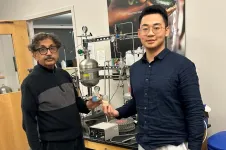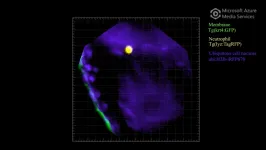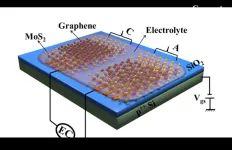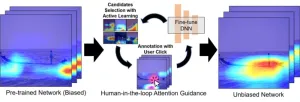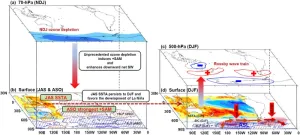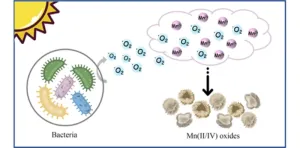(Press-News.org) Lehigh Engineering researcher Arup SenGupta has developed a novel way to capture carbon dioxide from the air and store it in the “infinite sink” of the ocean.
The approach uses an innovative copper-containing polymeric filter and essentially converts CO2 into sodium bicarbonate (aka baking soda) that can be released harmlessly into the ocean. This new hybrid material, or filter, is called DeCarbonHIX (i.e., decarbonization through hybrid ion exchange material), and is described in a paper recently published in the journal Science Advances.
The research, which demonstrated a 300 percent increase in the amount of carbon captured compared with existing direct air capture methods, has garnered international attention from media outlets like the BBC, CNN, Fast Company, and The Daily Beast, and professional organizations like the American Chemical Society. SenGupta himself has been fielding interest in the technology from companies based in Brazil, Ireland, and the Middle East.
“The climate crisis is an international problem,” says SenGupta, who is a professor of chemical and biomolecular engineering and civil and environmental engineering in Lehigh’s P.C. Rossin College of Engineering and Applied Science. “And I believe we have a responsibility to build direct air capture technology in a way that it can be implemented by people and countries around the world. Anyone who can operate a cell phone should be able to operate this process. This is not technology for making money. It’s for saving the world.”
The work is yet another extension of SenGupta’s personal and professional commitment to developing technologies that benefit humanity, and in particular, marginalized communities around the world. His research on water science and technology has included drinking water treatment methodologies, desalination, municipal wastewater reuse, and resource recovery. He invented the first reusable, arsenic-selective hybrid anion exchanger nanomaterial (HAIX-Nano), and as a result, more than two million people around the world now drink arsenic-safe water. Two of his patents have been recognized as “Patents for Humanity” by the US patent and Trademark Office.
His invention of DeCarbonHIX was the outcome of an ongoing CO2-driven wastewater desalination project funded by the Bureau of Reclamation under the jurisdiction of the U.S. Department of the Interior. SenGupta and his students were on the lookout for a reliable supply of CO2 even in remote places. That quest led the way to the field of direct air capture, or DAC, and the creation of DeCarbonHIX. This subject was the dissertation topic for environmental engineering student Hao Chen ’23 PhD, who successfully defended his PhD in March and will receive his doctorate in May.
Capturing carbon at lower concentrations
The most abundant of the greenhouse gasses contributing to global warming is carbon dioxide. In 2021, global emissions of CO2 rose by 6 percent from the previous year—to 36.3 gigatons, according to the International Energy Agency. Just one gigaton (equal to 1 billion tons) is the equivalent of the mass of all land mammals on earth.
Emissions from greenhouse gasses have increased global temperatures by approximately 1.1 degrees Celsius above pre-industrial levels, according to the Intergovernmental Panel on Climate Change. In its 2021 working group report, the IPCC estimates the average yearly temperature over the next 20 years is expected to rise by at least 1.5 degrees Celsius. The warmer the earth gets, the greater the fallout in terms of rising sea levels, extreme storm events, and ecological disruption, all of which have repercussions on global health, security, and stability.
“The worst part of this crisis is that people who are marginalized, who are poor, will suffer 10 times more than those who contributed to this situation,” says SenGupta.
There are three ways to reduce CO2, he says. The first—government action—can reduce emissions, but that won’t address what’s already in the air.
“The second way is removing it from point sources, places like chimneys and stacks where carbon dioxide is being emitted in huge amounts,” he says. “The good thing about that is you can remove it at very high concentrations, but it only targets emissions from specific sources.”
The newest method is called direct air capture, which, he says, “allows you to remove CO2 from anywhere, even your own backyard.”
With DAC, chemical processes remove CO2 from the atmosphere, after which it’s typically stored underground. However, says SenGupta, the technology is limited by its capacity. It can’t capture enough CO2 to overcome the energy cost of running the process.
“If you’re capturing carbon dioxide from a chimney at a plant, the amount of CO2 in the air can be upwards of 100,000 parts per million,” he says. “At that concentration, it’s easy to remove. But generally speaking, the CO2 level in the air is around 400 parts per million. That’s very high from a climate change point of view, but for removal purposes, we consider that ultra-dilute. Current filter materials just can’t collect enough of it.”
Another challenge with DAC involves storage. After the CO2 is captured, it’s dissolved, put under pressure, liquified, and typically stored miles underground. A DAC operation must then be located in an area with enough geological storage—and stability. A country like Japan, for instance, can’t pump CO2 underground because the area is prone to earthquakes.
Seeing a solution in seawater
SenGupta has developed a DAC method that overcomes both the capture problem and the issue of storage.
For the capture problem, he developed DeCarbonHIX—a mechanically strong, chemically stable sorbent (a material used to absorb liquids or gasses)—that contains copper.
“The copper changes an intrinsic property of the parent polymer material and enhances the capturing capacity by 300 percent,” he says. “We showed that for direct air capture from air with 400 parts per million of CO2, we achieve capacity, meaning capacity is no longer a function of how much carbon dioxide is in the air. The filter will get saturated completely at any concentration, which means you can perform DAC in your backyard, in the middle of the desert, or in the middle of the ocean.”
The ocean is actually SenGupta’s solution to the storage problem. His DAC process starts with air blowing through the filter to capture CO2. Once the filter is saturated with gas molecules (determined by measuring the amount of gas going into the filter versus coming out of it), seawater is passed through the filter. The seawater converts the carbon dioxide to sodium bicarbonate (you likely know it as baking soda, but lose the visual as we’re talking about a dissolved solution here). The dissolved sodium bicarbonate is then released directly into the ocean, what Sengupta calls “an infinite sink.”
“And it has no adverse impact on the ocean whatsoever,” says SenGupta. “It doesn’t change the salinity at all.”
In fact, he says, the sodium bicarbonate, which is slightly alkaline, may improve the health of the ocean. That’s because elevated levels of CO2 in the atmosphere have gradually reduced the pH of the ocean, causing acidification. More acidic waters harm the growth and reproduction of marine life like corals and plankton and can create catastrophic collapses in the food chain.
“Sodium bicarbonate may reverse that lowering of pH,” he says.
It’s worth noting, he says, that like existing DAC processes, DeCarbonHIX can also be desorbed with hot water or steam, and pure CO2 can be recovered, compressed, and stored underground in geological storage.
“In reality, this new filter material offers a dual mode of desorption and sequestration.”
Related Links:
Science Advances: "Direct air capture (DAC) and sequestration of CO2: Dramatic effect of coordinated Cu(II) onto a chelating..."
Faculty Profile: Arup K. SenGupta END
Path to net-zero carbon capture and storage may lead to ocean
New filter technology developed at Lehigh University effectively captures ‘ultra-diluted’ CO2 in the air we breathe. In the future, a system powered by renewable energy could use seawater to convert and store it safely.
2023-03-31
ELSE PRESS RELEASES FROM THIS DATE:
Association between daily alcohol intake and risk of all-cause mortality
2023-03-31
About The Study: In this updated systematic review and meta-analysis of 107 studies involving more than 4.8 million participants, daily low or moderate alcohol intake was not significantly associated with all-cause mortality risk, while increased risk was evident at higher consumption levels, starting at lower levels for women than men.
Authors: Jinhui Zhao, Ph.D., of the University of Victoria in Victoria, British Columbia, Canada, is the corresponding author.
To access the embargoed study: Visit our For The Media website at this link https://media.jamanetwork.com/
(doi:10.1001/jamanetworkopen.2023.6185)
Editor’s ...
Racial, ethnic differences in insurance after job loss during COVID-19
2023-03-31
About The Study: While the decline in employer-sponsored insurance in 2020 was offset by an increase in Medicaid coverage among newly unemployed white working-age adults, there was no such rise among newly unemployed Black and Hispanic workers.
Authors: Peter J. Huckfeldt, Ph.D., of the University of Minnesota School of Public Health in Minneapolis, is the corresponding author.
To access the embargoed study: Visit our For The Media website at this link https://media.jamanetwork.com/
(doi:10.1001/jamahealthforum.2023.0168)
Editor’s Note: Please see the article for additional information, including ...
Pictures inside a cell: USC researchers develop new tool to provide greater insight into biological processes
2023-03-31
A groundbreaking technique developed by researchers affiliated with the USC Michelson Center for Convergent Bioscience presents a new way of gathering and organizing highly detailed information about organic tissues in record time.
The methods could someday be used to rapidly process tissue biopsies in cancer care or detecting bacteria in food processing plants.
Tissues emit signals, or intrinsic fields, that while detectable are very weak and hard to differentiate. The technique, detailed in a pair of papers published in Nature Methods ...
Vaginal microbiome does not influence babies’ gut microbiome
2023-03-31
New University of British Columbia research is challenging a longstanding assumption that a baby’s gut microbiome is primarily shaped by their mother’s vaginal microbiome, while shedding new light on the factors that do influence its development.
When babies are born, their gut is a nearly sterile environment. But that quickly changes as the infant’s digestive tract becomes home to trillions of microbial cells throughout their early development. This gut microbiome is an important part of overall health and alterations early in life have been associated with negative health outcomes later on, including asthma and obesity.
It has ...
Green technologies for a greener environment
2023-03-31
About Book:
Green tech refers to materials and technology that are used to reduce adverse human impact on Earth. It encompasses a wide area of scientific research, including energy, atmospheric science, agriculture, material science, and hydrology.
Using sustainable resources to produce energy for a better greener tomorrow has been at the epicentre of man’s thought since 1987, in the United Nations Brundtland Report was published, which defined sustainable development as “needs of the present without compromising the ability of future generations to meet their own needs”.
It has real-world examples some ...
Novel supercapacitor for energy storage applications
2023-03-31
Researchers at the Department of Instrumentation and Applied Physics (IAP), Indian Institute of Science (IISc), have designed a novel ultramicro supercapacitor, a tiny device capable of storing an enormous amount of electric charge. It is also much smaller and more compact than existing supercapacitors and can potentially be used in many devices ranging from streetlights to consumer electronics, electric cars and medical devices.
Most of these devices are currently powered by batteries. However, over time, these batteries lose their ability to store charge and therefore have a limited shelf-life. Capacitors, on the other hand, can store electric charge for much ...
Click away the bias: New system to make AI training easier and more accurate
2023-03-31
Ishikawa, Japan -- In the past few years, “AI” has become a major buzzword in technology. The prospect of a computer being able to do tasks which only a human could perform is a captivating thought indeed! AIs can be created using multiple different methods, but one of the most popular ones right now involves the use of deep neural networks (DNNs). These structures try to mimic the neural connections and function of the brain and are generally trained on a dataset before they are deployed in the real world. By training them on a dataset beforehand, ...
Danish researchers discover birds with neurotoxin-laden feathers
2023-03-31
The poisonous birds inhabit one of Earth’s most pristine rainforests, a place as exotic as no other in the world. Hearing the words poisonous and bird coupled will be an eye-opener for most. But poisonous birds actually exist. And now, more species have been discovered in New Guinea’s jungles.
"We managed to identify two new species of poisonous birds on our most recent trip. These birds contain a neurotoxin that they can both tolerate and store in their feathers," says Knud Jønsson of the Natural History Museum of Denmark.
Jønsson and fellow UCPH researcher, Kasun ...
What caused the record-low Antarctic sea ice in austral summer 2022?
2023-03-31
Antarctic sea ice is an important component of the climate system, and may act as an early indicator of climate change. Under global warming, significant changes in Antarctic sea ice have been observed. Specifically, it experienced a slow increase during 1979–2014, but a rapid decline thereafter. Despite a modest recovery after the record minimum in 2017, the sea ice area during austral summer 2022 (December 2021 to February 2022) again hit a new record minimum, at 3.07 million km2, which is approximately a 25% reduction compared with its long-term mean during 1981–2010. The largest decline occurred in two regions: the central-eastern Ross Sea ...
Visible light-induced superoxides production by bacteria accelerates manganese oxidation in the environment
2023-03-31
Manganese oxides are natural reactive minerals and widely spread in aquatic and terrestrial environments, affecting the fate of metals (such as As3+ and Cd2+) and organic pollutants (such as phenols and diclofenac) through adsorption and oxidation in sewage treatment. Usually, the manganese (III/IV) oxides in the environment are thought to be formed by the oxidation of dissolved Mn(II) through abiotic or biotic processes. Oxidation of aqueous Mn(II) by dissolved oxygen is thermodynamically favored, but the kinetic is slow due to the high energy barrier of the reaction from dissolved ...
LAST 30 PRESS RELEASES:
Scientists trace microplastics in fertilizer from fields to the beach
The Lancet Obstetrics, Gynecology, & Women’s Health: Taking paracetamol during pregnancy does not increase risk of autism, ADHD or intellectual disabilities, confirms new gold-standard evidence review
Taking paracetamol during pregnancy does not increase risk of autism, ADHD or intellectual disabilities
Harm reduction vending machines in New York State expand access to overdose treatment and drug test strips, UB studies confirm
University of Phoenix releases white paper on Credit for Prior Learning as a catalyst for internal mobility and retention
Canada losing track of salmon health as climate and industrial threats mount
Molecular sieve-confined Pt-FeOx catalysts achieve highly efficient reversible hydrogen cycle of methylcyclohexane-toluene
Investment in farm productivity tools key to reducing greenhouse gas
New review highlights electrochemical pathways to recover uranium from wastewater and seawater
Hidden pollutants in shale gas development raise environmental concerns, new review finds
Discarded cigarette butts transformed into high performance energy storage materials
Researchers highlight role of alternative RNA splicing in schizophrenia
NTU Singapore scientists find new way to disarm antibiotic-resistant bacteria and restore healing in chronic wounds
Research suggests nationwide racial bias in media reporting on gun violence
Revealing the cell’s nanocourier at work
Health impacts of nursing home staffing
Public views about opioid overdose and people with opioid use disorder
Age-related changes in sperm DNA may play a role in autism risk
Ambitious model fails to explain near-death experiences, experts say
Multifaceted effects of inward foreign direct investment on new venture creation
Exploring mutations that spontaneously switch on a key brain cell receptor
Two-step genome editing enables the creation of full-length humanized mouse models
Pusan National University researchers develop light-activated tissue adhesive patch for rapid, watertight neurosurgical sealing
Study finds so-called super agers tend to have at least two key genetic advantages
Brain stimulation device cleared for ADHD in the US is overall safe but ineffective
Scientists discover natural ‘brake’ that could stop harmful inflammation
Tougher solid electrolyte advances long-sought lithium metal batteries
Experts provide policy roadmap to reduce dementia risk
New 3D imaging system could address limitations of MRI, CT and ultrasound
First-in-human drug trial lowers high blood fats
[Press-News.org] Path to net-zero carbon capture and storage may lead to oceanNew filter technology developed at Lehigh University effectively captures ‘ultra-diluted’ CO2 in the air we breathe. In the future, a system powered by renewable energy could use seawater to convert and store it safely.
